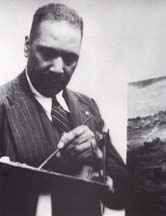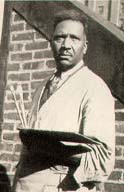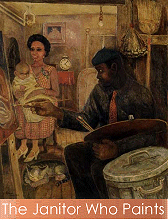 Palmer
Palmer Hayden
Defined Art During the Harlem Renaissance
By:
Suzanne Benedetto
“Contrary to the conventional wisdom which would have predicted a pessimistic world view during the Depression, painter Archibald J. Motley Jr. and Palmer C. Hayden saw the world as teeming with life, leisure, and a touch of lowbrow” (Powell 68).

Works Cited and Additional Sources
“Between 1916 and 1940, there occurred an artistic revolution in black America. It was driven by political and economic circumstances in the United States, world events, and changes in attitudes of African Americans about themselves and of whites about African-Americans” (Haskins 13). This time period concentrated in Harlem, was called the Harlem Renaissance. The Harlem Renaissance was a long awaited time for the Black man and woman to showcase his or her talents in the areas of art, music, and literature, all of which contributed to the cultural and political movement made by the once oppressed African-American. Art created during the Harlem Renaissance especially flourished. Black artists such as Aaron Douglas, Augusta Savage, as well as Palmer Hayden’s beautiful masterpieces of paintings and sculptures were recognized and valued for the first time.
. 
Watercolor on paper; illustrated the care-free dance and music inspired
lifestyle of the Harlem Renaissane
~~~~~~~~~~~~~~~~~~~~~~~~~~~~~~~~~~~~~~~~~~~~~~~~~~~~~~~~~~~~~~~~
Palmer Hayden was born in Widewater, Virginia on January
15, 1890. As a young man he served
in World War I; where he was given the name Palmer Hayden by a Sergeant who was
unable to pronounce his birth name, Peyton Hedgemen.
As a young boy he dreamed of playing the fiddle, but due to lack of
finances and his timid demeanor he never got to do so.
He did continue to draw though and as an adolescent he moved to
Washington D.C. and worked as a porter, errand boy, and drew scenes of the
Potomac. The fishing boats and
sailboats he portrayed on the Potomac were subjects and inspirations for many of
his most famous painting.gif) s (Hanks 3). Those
paintings would be the source of his success later on.
He joined the army in order to have time and the income to draw; worked
as a postman, which allowed little time for art; then decided on becoming a
janitor. He having a less
than glamorous job was something that he would continue to be associated with.
In fact when he won a coveted art prize and traveled abroad people said
about him: “House cleaner quits scrub bucket job to work abroad”
(VIDEO).
Back to top
s (Hanks 3). Those
paintings would be the source of his success later on.
He joined the army in order to have time and the income to draw; worked
as a postman, which allowed little time for art; then decided on becoming a
janitor. He having a less
than glamorous job was something that he would continue to be associated with.
In fact when he won a coveted art prize and traveled abroad people said
about him: “House cleaner quits scrub bucket job to work abroad”
(VIDEO).
Back to top

“In this symbolic self-portrait, the painter is at work in his basement studio, surrounded by the tools of his dual professions, a palette, brushes and easel, and a garbage can, broom and feather duster” (Palmer Hayden 1). Ironically, Palmer had been a janitor in the Harmon Center where his work was displayed. It caused controversy because of its subjects being drawn in a cartoonish manner, exemplifying offensive stereotypes. “Hayden insisted he was not poking fun at black people or acceding to white stereotypes, but depicting an era, with all the comedy and tragedy of black life. It was more affectionate” (Haskins 151). He did redo the painting though making the lips of all subjects thinner and changing a defiled portrait of Abraham Lincoln to one of a cat. He did not intend to offend anyone , but rather make endearing portraits of his own people. “Starkly contrasting Bruegel, who depicts the lower class, but doesn’t truly delve into their lives, Hayden brings to the lifestyle the African-American’s public eye, causing the repressed class to be represented in artwork, and thus suggesting that their artwork is linked to the movement towards equality” (Palmer 1). Back to top
Works Cited & Additional Resources
Hanks, Eric. Journey From The Crossroads: Palmer Hayden’s Right Turn. 19 January 2003. http://www.mhanksgallery.com/hayart.html
Art In the Harlem Renaissance. Videocassette. A&E Documentary.
Haskins, Jim. The Harlem Renaissance. Brooksfield, Connecticut: The Millbrook Press, 1996.
Palmer Hayden. 19 January 2003. http://www.stanford.edu/~tshih/Hayden.html
Palmer Hayden (1890-1973) http://ryder.si.edu/artdir/text.bak/artist h/haydp01x.html
Powell, Richard J. Black Art and Culture in the 20th Century. New York: Thames and Hudson Inc,1997.
Gallery of Hayden's Work: http://www.nku.edu/~diesmanj/hayden.html